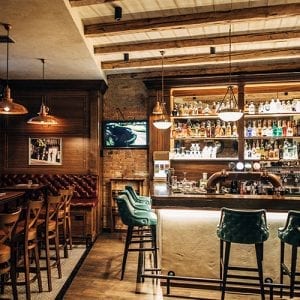Restaurant Revitalization Fund
Restaurant Revitalization Fund Grant Overview
 IMPORTANT UPDATE: The Restaurant Revitalization Fund portal will close on July 14, 2021, and restaurant owners who have not received funding as of July 1, 2021, but who have already applied, "will have their applications held within the application platform to allow for processing in the order received if additional funds are provided by Congress." For more information about the closure of the Restaurant Revitalization Fund portal, click here.
IMPORTANT UPDATE: The Restaurant Revitalization Fund portal will close on July 14, 2021, and restaurant owners who have not received funding as of July 1, 2021, but who have already applied, "will have their applications held within the application platform to allow for processing in the order received if additional funds are provided by Congress." For more information about the closure of the Restaurant Revitalization Fund portal, click here.
We have retained the following information regarding the Restaurant Revitalization Fund to prepare you for the application process when and if Congress approves another round of funding. We will continue to update this page as new information is obtained.
With the passage of the American Rescue Plan Act of 2021, a $26 billion Restaurant Revitalization Fund Grant (RRFG) was established to help restaurants across the country recover from the hardship put on them as a result of the COVID-19 pandemic. Rea & Associates has been committed to putting out resources and insight for businesses that may be eligible to receive these funds. We understand there are a lot of questions out there pertaining to the application process, eligibility, etc. So, we wanted to do our best to compile as many resources as possible in a simple, singular location. Keep scrolling to learn more about the RRFG. If you have questions or need assistance, reach out to your Rea advisor today, or click the "Contact Us" bottom on the top, right of your screen.
Get Ready, Get Set, Apply!
Register
The first step, when it comes to applying for a restaurant revitalization fund grant, is to register at the Small Business Association (SBA) portal (The portal is closed to new applicants as of July 14, 2021). Once you are a registered user, you will receive log-in credentials. At that point, take a look around and become familiar with the web portal. Also, consider bookmarking the website, which will make it easier to come back to the site if necessary.
Compile
Next, you'll want to collect and compile all necessary business documents. Take your time on this step and be thorough. If your application is submitted with incomplete documentation, it will be rejected. Unfortunately, this "wasted time" could ultimately prohibit you from actually receiving a grant as there is substantial demand for relief. These documents must be in one of the following formats to allow for easy upload into the portal.
- JPG
- GIF
- TIFF
- PNG
For further clarification on the specific documents, you'll need to apply, scroll down a little further, and expand the appropriate section based on your entity's specific circumstances.
Prepare
These funds are expected to go quickly. So, to ensure that you are in the best position to receive the funding you need, prepare your space and your tools. This means, ensure that you have access to a strong internet connection well before applications are set to be accepted at noon on Monday, May 3. You may also want to make sure you are using a reliable internet browser and that the one you are using is updated and ready to go. The SBA reports that Chrome, Firefox, Safari, and the Chrome-based Edge browsers are all supported at this time. Internet Explorer and legacy versions of Edge, however, are not supported.
Additionally, you should familiarize yourself with the application process to help reduce any hiccups that might occur. You can do this by:
- Reviewing the sample application
- Taking a look at the updated program guide
- Check out the cross-program eligibility chart
Go!
As soon as the SBA opens its virtual doors and begins to accept applications, you should already be in a great position to complete the required application. Once it's been submitted, a DocuSign package will be sent to you via email. It's important that you open the email and follow the instructions included with the DocuSign package immediately as your prompt action in this step will officially trigger the SBA's review process.
Distribution of funds will first be made to Priority Groups over the first 21 days. However, we strongly recommend all eligible restaurants to apply as soon as possible regardless of whether or not your business falls into one of the priority categories. This will ensure that your application is received and positioned closer to the front of the line. This is important since the funds will be dispersed on a first-come, first-served basis. The application portal will remain open to any eligible establishment until all funds are exhausted.
To learn more about the "priority period," and whether you meet the eligibility requirements for owning a priority small business, scroll down and expand the section that addresses RRFG prioritization.
Additionally, if you would like more information directly from the SBA, you can view this recent webinar, which covers the RRFG program in detail and offers a demonstration of the application portal.
Wait
Once your application and accompanying documentation are submitted and have entered into the review stage, the SBA will take about two weeks to review your submission and arrive at a decision with regard to whether your business is eligible to receive an RRFG. If you are anxious, however, and want to check on your application to determine where it is in the process, you will be able to check it by using your confirmation number.
If your application is approved, your RRFG funds will be deposited into the bank account that was entered and submitted with your application.

Restaurant Revitalization Grant Resources, Tips, & Insight
RRFG Eligibility
 To be eligible for the RRFG, your business must be one where the public or patrons are allowed to assemble for the primary purpose of being served food and/or drink. This would include:
To be eligible for the RRFG, your business must be one where the public or patrons are allowed to assemble for the primary purpose of being served food and/or drink. This would include:
- Restaurants
- Food stands
- Food trucks
- Food carts
- Snack bars
- Nonalcoholic beverage bars
- Caterers
- Bars
- Lounges
- Saloons
- Taverns
- Licensed facilities or premises of a beverage alcohol producer where the public is allowed to taste, sample, or purchase products
- Other similar places of businesses in which the public or patrons are allowed to assemble for the primary purpose of being served food or alcohol.
Other entities, listed below, are also eligible for funding with certain limitations. However, in addition to eligibility will be limited to entities with onsite sales of food and beverage to the public of at least 33 percent of gross receipts, owners of the following entities may need to provide additional information when applying.
- Inns
- You may need to share evidence of your onsite sales.
- Breweries, brewpubs, microbreweries, taprooms, and tasting rooms, bakeries, wineries, distilleries
- You may need to share filed Tax and Trade Bureau reports for the gross receipts reporting period.
Clarifications
It’s also important to note that, to receive an RRFG, there is no requirement to meet that states your entity had to be open prior to a certain date. In fact, the grant language states that even if your entity was not open prior to Jan. 1, 2020, it is still eligible for the grant. Furthermore, even if your entity didn’t open by the application date, it can still apply for eligible expenses that may have been incurred in preparation for opening. According to the FAQ released by the National Restaurant Association, for entities opened or that were planning to open after Jan. 1, 2020, the grant fund eligibility generally follows a formula similar to:
[Eligible Expenses Incurred] – [Gross Receipts] – [PPP Loans] = RRFG Funding
As you can see from the formula presented above, your business is still eligible for RRFG funding even if you’ve already received the first-draw (and even the second-draw) Paycheck Protection Plan (PPP) loans. The only caveat is that the amount of your RRFG will be reduced by the total amount of your PPP funding.
Not all restaurants, bars, and similar entities will be eligible for a Restaurant Revitalization Grant as there are certain disqualifying circumstances. Your entity may be disqualified from RRFG eligibility if:
- As of March 13, 2020, you owned or operated more than 20 locations. This is regardless of whether your restaurant locations do business under the same name or different names.
- You have already received a Shuttered Venues Operations Grant (SVOG) or your application for this grant type is still pending.
- Yours is a publicly traded corporation or is majority-owned and controlled by a publicly traded corporation.
- Your business entity is not primarily operating within the U.S., does not have a place of business within the U.S., and doesn’t make a significant contribution to the overall U.S. economy through the payment of taxes or use of American products, material, or labor.
- Your entity is owned or operated by a state- or local government.
- Your establishment is now permanently closed.
- You filed for bankruptcy under Chapter 7 or liquidated under Chapter 11.
- You have filed for bankruptcy under chapters 11, 12, or 13, but do not yet have an approved plan for reorganization.
Will You Be Able To Apply First?
 While the RRFG application period officially opens at noon on Monday, May 3, 2021, only a few select groups will be considered during the first 21 days.
While the RRFG application period officially opens at noon on Monday, May 3, 2021, only a few select groups will be considered during the first 21 days.
Small businesses that are at least 51 percent owned by one or more individuals who are women, veterans, or socially and economically disadvantaged will be given priority over other applicants until May 22, 2021, when applications will be then accepted by all other eligible applicants at the order in which they are received and approved by the SBA. Those who are considered "socially disadvantaged individuals," are those who have been subjected to racial or ethnic prejudice or cultural bias because of their identity as a member of a group without regard to their individual qualities. Those who fit the description of "economically disadvantaged individuals," are socially disadvantaged individuals whose ability to compete in the free enterprise system has been impaired due to diminished capital and credit opportunities as compared to others in the same business area who are not socially disadvantaged.
If you fit these criteria, you must self-certify on the application. This will give your application priority and the SBA will review it over the first 21 days of the application period going live.
How To Use Your Funds
 It's very important that any funds received as a result of the Restaurant Revitalization Grant are used for eligible expenses as determined by the federal government. To ensure that the money is being used as intended, recipients will be required to certify their spending on the SBA portal. The following expenses, as long as they were incurred between Feb. 15, 2020, and March 11, 2023, are eligible to be offset by funds received through this particular grant.
It's very important that any funds received as a result of the Restaurant Revitalization Grant are used for eligible expenses as determined by the federal government. To ensure that the money is being used as intended, recipients will be required to certify their spending on the SBA portal. The following expenses, as long as they were incurred between Feb. 15, 2020, and March 11, 2023, are eligible to be offset by funds received through this particular grant.
- Business payroll costs, including sick leave and costs related to the continuation of group health care, life, disability, vision, or dental benefits during periods of paid six, medical, or family leave, and group health care, life disability, vision, or dental insurance premiums.
- Payments on any business mortgage obligation (both principal and interest). This does not include any prepayment of the principal on a mortgage obligation).
- Business rent payments, including rent under a lease agreement. This, however, does not include any prepayment of rent.
- Business debt service - both principal and interest. Please note that this does not include any prepayment of principal or interest.
- Business utility payments for the disruption of electricity, gas, water, phone, or internet access, or any other utility that is used in the ordinary course of business for which service began before March 11, 2021.
- Business maintenance expenses, including maintenance on walls, floors, deck surfaces, furniture, fixtures, and equipment.
- Construction of outdoor seating.
- Business supplies, including protective equipment and cleaning material.
- Business tool and beverage expenses, including raw materials for beer, wine, or spirits.
- Covered supplier costs, which is considered an expenditure made by you to a supplier of goods for the supply of goods that are considered essential to the operations of your business at the time the expenditure was made and is made pursuant to contract, order, or purchase order in effect at any time before the receipt of Revitalization Revitalization funds; or with respect to perishable goods, a contract, order, or purchase in effect before or any time during the covered period.
- Business operating expenses, which are defined as business expenses incurred through normal business operations that are necessary and mandatory for the business. Examples might include rent, equipment, supplies, accounting, training, legal, etc.
Note: Past-due expenses ARE eligible, as long as they were incurred beginning Feb. 15, 2020, and ending March 11, 2021.
 According to the SBA, a set amount of funds have been made available to three different groups - determined by their gross receipt totals. According to the agency's website:
According to the SBA, a set amount of funds have been made available to three different groups - determined by their gross receipt totals. According to the agency's website:
- $5 billion has been set aside for applicants with 2019 gross receipts of not more than $500,000.
- An additional $4 billion is set aside for applicants with 2019 gross receipts totaling between $500,001 to $1,500,000
- An additional $500 million is set aside for applicants with 2019 gross receipts of not more than $50,000.
NOTE: The SBA reserves the right to reallocate the funds at the discretion of the administrator.
RRFG Calculations
 There are a lot of questions pertaining to the payment calculations associated with the RRFG, specifically with regard to how long a restaurant has been in business and whether it received Payroll Protection Program (PPP) funds. Below are three calculations based on three key scenarios:
There are a lot of questions pertaining to the payment calculations associated with the RRFG, specifically with regard to how long a restaurant has been in business and whether it received Payroll Protection Program (PPP) funds. Below are three calculations based on three key scenarios:
Applicants In Operation Prior To Or On Jan. 1, 2019:
2019 gross receipts - 2020 gross receipts - PPP loan amounts = RRFG amount
Applicants That Partially Began Operations Through 2019
(average 2019 monthly gross receipts x 12) - 2020 gross receipts - PPP loan amounts = RRFG amount
Applicants That Began Operations On Or Between Jan. 1, 2020, and March 10, 2021
AND
Applicants That Have Not Opened Yet, But Have Incurred Eligible Expenses
Amount spent on eligible expenses between Feb. 15, 2020 and March 11, 2021 - 2020 gross receipts - minus 2021 gross receipts (through March 11, 2021) - PPP loan amounts = RRFG amount
While your RRFG amount will be, for the most part, based on the calculations outlined above, the SBA may provide funding up to $5 million per location, but not to exceed $10 million total for the applicant and any affiliated business. The minimum award that will be given is $1,000.
Gross Receipts Defined
The SBA, for the purposes of the RRFG, does not include the following amounts in an applications calculation of gross receipts:
- Amounts received from PPP loans - first draw and second draw loans
- Amounts received from Economic Injury Disaster Loans (EIDL)
- Advances on EIDL (EIDL Advance and Targeted EIDL Advance)
- State and local grants (via the CARES Act or other program)
- SBA Section 1112 payments
